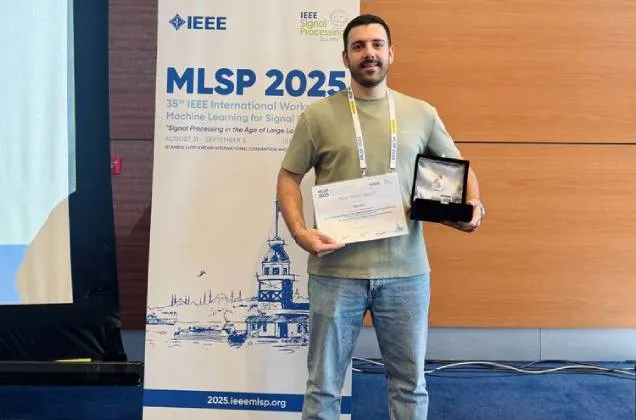29/05/2015
Turkey's first and only “Behavioral Analytics & Visualization Lab”

Sabancı University and MIT partnered for the establishment of the Behavioral Analytics & Visualization Lab.
This will be Turkey's first and only lab on the subject of big data analytics.
Sabancı University takes another step in the strategic partnership with the Massachusetts Institute of Technology the Behavioral Analytics & Visualization Lab was established within Sabancı University. An introduction meeting was held on Monday, May 25th, 2015 at the Karaköy Minerva Palas for Turkey's first and only lab on the subject.
The meeting began with introductory remarks by Sabancı University President Professor Nihat Berker. Speaking next was MIT Media Lab founder and World Economic Forum Big Data Initiative Cochair Professor Alex Pentland, who discussed “Big Data Analytics and the Importance of Cooperation." Professor Pentland began by speaking about wearable technology development at MIT in 1995. He explained the data acquired as a result of those studies, and that some of the technologies in use today were developed in those years. Professor Pentland said that these technologies enabled the collection of big data, and gave examples of areas where big data is used, from the medical industry to apparel. Professor Pentland commented that the data generated enable people to cooperate and socialize more in both their professional and social lives.
Finally, lab directors Sabancı University School of Management faculty member Associate Professor Burçin Bozkaya and Faculty of Engineering and Natural Sciences member Associate Professor Selim Balcısoy spoke on the activities to take place in the lab.
Associate Professor Burçin Bozkaya said that Big Data Analytics is increasing in importance and scope every year, and that large databases acquired in many different industries and applications can be analyzed for a variety of reasons to be converted into outputs for the betterment of individuals and societies. An example was analyzing search patterns for "flu" on search engines to determine the rate at which the virus spreads, informing the right people at the right time and allocating treatment resources accurately. Another example is analyzing the social media behavior and posts of a Facebook user to determine if he or she is going through any major life events such as graduation, marriage, new job, losing a job and others to make them offers that will simplify their life.
Associate Professor Bozkaya underscored the importance of protecting personally identifiable information, saying that regardless of the extent to which databases are anonymized, location and time data may cause people to be identified again, and that data privacy would be the highest of priorities in the work done in the laboratory and in the publication of outcomes.
Associate Professor Selim Balcısoy introduced the virtual Istanbul desk developed by data visualization. Associate Professor Balcısoy explained that the purpose of data visualization is to stimulate the sense of sight, helping people make sense of complex data. Balcısoy said that conventional computer interaction was used as a method to analyze complex data, but there were problems regarding joint work and starting analysis without lengthy user training procedures. Associate Professor Balcısoy explained that the nature of humans was to learn by touching and observing rather than using a keyboard and a mouse, which was why current computer interaction techniques and visualizations were unable to fulfill this need completely.
Associate Professor Selim Balcısoy continued, “When we analyzed research, we determined that we could overcome restrictions and interaction issues between studies on spatial screens and their physical visualizations. We built a data visualization system for this purpose, which projects images onto a passive or active physical visualization coming from a 3D printer. The Istanbul desk is one of the first examples of this work. Thanks to this environment of study and research, we can conduct interactivity studies on physical visualizations. As a result of this work, physical visualizations can work in interaction with spatial screens to build a system that allows users to jointly analyze complex and heavy data quickly and effectively. A literature survey showed that no similar system exists and there is a significant gap in physical visualization solutions focusing on data analysis." Balcısoy concluded that the Istanbul desk would be an important tool to make sense of and analyze data which would gather decision-makers, analysts and other stakeholders around the same set of data.
About the Behavioral Analytics & Visualization Lab
Big data analysis is becoming more important and widely available every day. Prior to the foundation of the lab, Sabancı University, MIT Media Lab and the leading financial companies collaborated to conduct studies on this subject. When these studies yielded positive results, it was decided to continue research within a larger and more comprehensive Lab. Big Data is particularly important for finance, telecom, retail, research and medical industries. A company may benefit from research on Big Data provided by itself, or from the analysis of results obtained in a different industry. These results can also be converted into new business models, products and services.
The lab will be the setting for close cooperation and joint research with MIT Media Lab Human Dynamics Group faculty and researchers. The Human Dynamics Group strives to explain the behavior of people in daily life and social settings based on the analysis of Big Data collected from various sources, and seeks to develop mathematical models and techniques for predicting such behavior. These subjects are included in the areas of interest and study for the new lab, where exercises will include "data visualization" or the visualization of databases of complex relations to make sense of data.
The big data analytics work at the Sabancı Behavioral Analytics & Visualization Lab will explain the behavior of individuals, social groups and consumers in different settings by mathematical models and relations. Models and findings acquired as a result of these studies will have the potential to help associated groups, industry analysts and executives to create demos and prototypes for developing new business models. The results will also be applicable to business. There is also the possibility of obtaining findings and results that will be closely relevant to the academic world in terms of fundamental research.
Graduate and doctorate students and postdoctoral researchers are expected to work in the lab under the supervision of Sabancı University and MIT faculty members. The lab will lead research projects on data from different sources to be supplied by strategic partners. Students will be able to conduct research that will help towards their master's or PhD dissertations.




